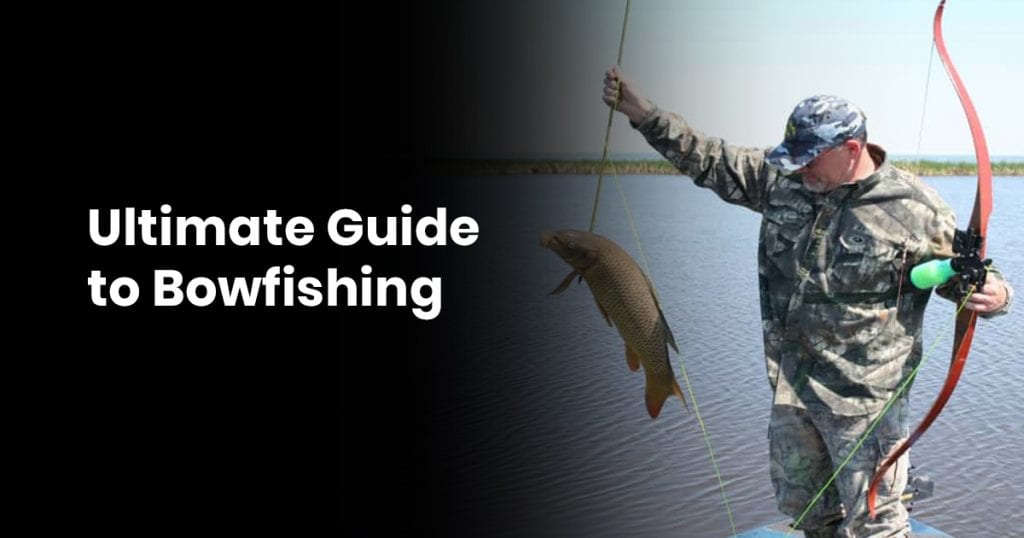When springtime comes around, do you get sad?
Bow hunting season is done and now what do you do?
If you’re like many bow hunters the arrival of spring and summer means putting the bow away or settling for target practice.
Sure, fishing is OK, but if you miss the feel of your compound bow, the spring and summer can seem like an eternity.
This doesn’t have to be the case.
Did you ever consider bow fishing?
Bowfishing is a great way to combine a fun summer activity, with your favorite fall and winter activity – bow hunting in United States.
Bowfishing is not only a great way to keep up your bow skills through the summer, without the boring targets, but it is also a way to improve your speed and accuracy.
Bowfishing is the perfect bridge between the archery season, for the dedicated bow person.
If you’ve never been bowfishing before, you probably have some questions.
In this guide, we’ll give you the rundown on everything you need to know about bowfishing, and how you can transition from bow hunting on land, to using your standard bow for fishing.
What do you need for bowfishing?
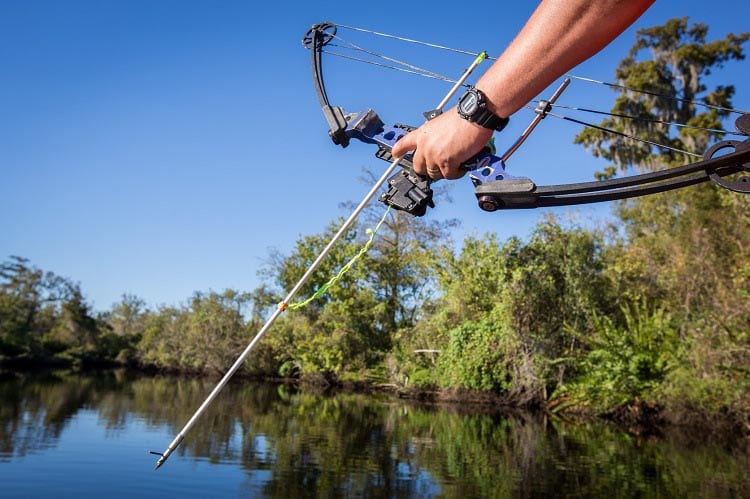
There seems to be a misconception that bowfishing requires a substantial amount of gear and equipment.
The reality is that you probably need less gear for bowfishing than you need for bow hunting.
Old Bow – New Bow
Because you’re going to be getting this bow wet, you might not want to use the same bow that you use during the hunting season.
For bowfishing, you will want to invest in a second bow.
Don’t worry though, it doesn’t need to be the top of the line or brand new bow.
Many bow hunters transition into bowfishing with a used old bow, or an older bow that hasn’t been used for hunting in a while.
There are a couple of considerations that you need to keep in mind when you are selecting a bowfishing bow for the first time.
First, make sure that the bow that you are using properly fits your draw length.
Second, make sure that the bow’s draw weight ranges between 25 and 50 pounds.
This will be sufficient for creating enough speed and kinetic energy force to push the arrow through the water, and still, have enough force to strike your fish.
You can also use your modern crossbow.
However, make sure that crossbow fishing is allowed where you live.
Some states allow bowfishing, but not using a crossbow.
Best Choice Arrows/Tips
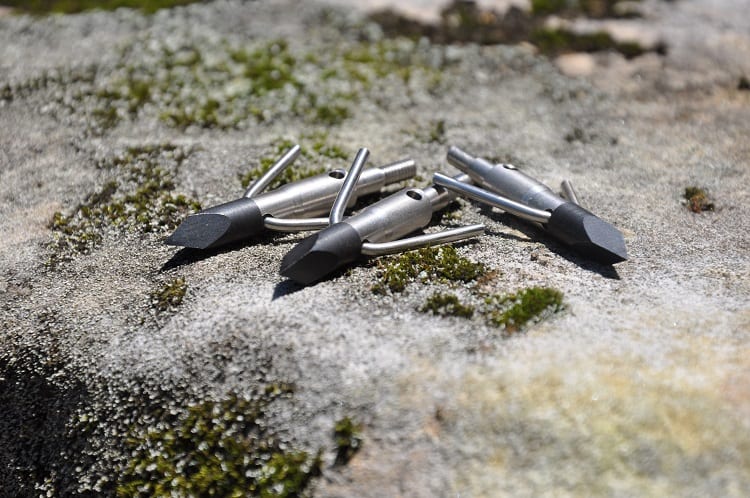
Don’t skimp on arrows.
Lightweight arrows won’t give you enough weight to push through the water and maintain direction and force.
Make sure that you select arrows that are made specifically for bowfishing.
They will give you enough strength combined with a good weight for a successful fishing trip.
When selecting tips, make sure that you find a tip that will stay with the fish, but not causes too much damage.
Many bow fishers will tell you that a grapple tip is a good choice.
The reality is that you can find good arrows with tips already added that are specifically for bowfishing.
If you are new to bowfishing this is a good option, to help you learn what works.
Just remember, these two items are crucial to bringing in your fish, so don’t be cheap!
Reel and Line
Just like with a fishing pole, you’re going to need a reel and line to bring in your fish.
You have two options for reels: bottle-style or spin-cast reels.
The type of reel that you choose depends on preference and can depend on where you are fishing.
Bottle style reels require that you reel your catch in by hand.
When you shoot your arrow, the line will unravel from the reel, but you will have to re-coil the line by hand.
Spincast reels for bowfishing are just like spin-cast reels for regular fishing.
These reels will allow you to work a fish once it’s on your arrow, just like you would with a fishing rod.
Spincast reels also have the advantage of helping you reel in your catch.
Many bow fishers prefer this type of reel over the bottle-style, simply due to the fact that you don’t have to recoil line by hand.
Polarized Sunglasses
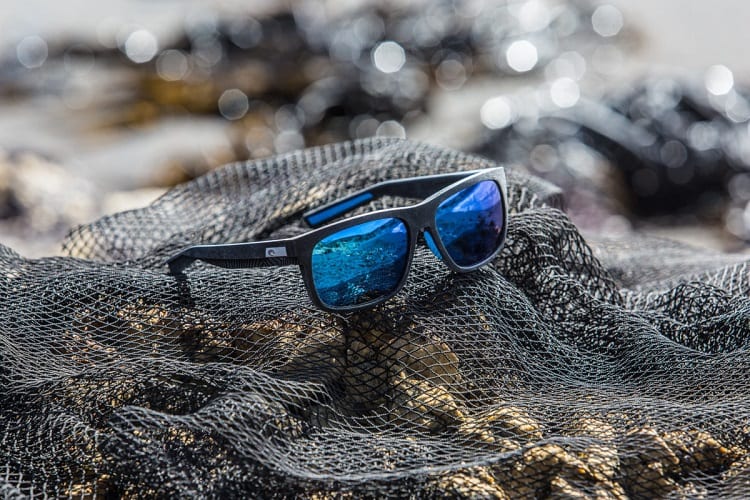
Being able to gauge the distance to a fish or the right angle to shoot can be difficult, when you’re looking at your target through the water.
Light refracts off the water and changes the perspective your eyes see.
This problem can be minimized with a good pair of polarized sunglasses.
Polarized sunglasses will help improve your fishing skills, but they also provide important protection from sun rays bouncing back from the water, and from UV rays.
Being outside for an extended period of time, especially on a sunny day can be harmful to your eyes.
Make sure that your polarized sunglasses also protect against 100 percent of UVA and UVB rays.
There’s nothing more painful than having sunburned eyes.
Waders – Different Models
This is an optional piece of equipment for sure.
Some people don’t mind wading through the water in a pair of old shoes or muck boots and a pair of shorts.
However, if you aren’t this person, or if you are starting your bowfishing adventures early in the spring when water temperatures are still a bit cold, a pair of waders are a great piece of equipment to invest in.
When buying waders, make sure that you select a pair that has hard soles, not felt soles.
Felt soled waders are known to carry aquatic nuisance species from one body of water to another.
Gloves For Big Game Bowfishing
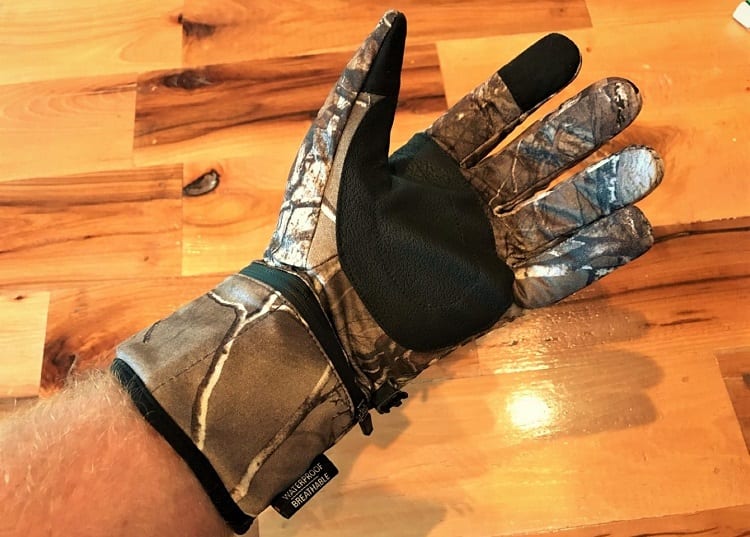
Gloves are handy for two things.
First, if you’re using a bottle-style reel, you want to avoid cutting your hands when you are pulling in your fish.
The glove is particularly helpful in this case if you are fishing for large species like carp or gar.
Another reason to wear gloves is to add some additional grip when handling your fish.
Fish are slippery, so having a good pair of gloves can go a long way in helping you keep hold of your catch.
Finally, for some people, touching fish is an unpleasant experience.
If you are one of those people that like to fish but don’t like to touch a fish gloves are a must.
Boat For Peak Season
We list this item last because you really don’t need a boat to bow-fish, and in some ways, a boat can be more of a hindrance than a help.
If you are ocean fishing or fishing in a deep lake, a boat is a must.
However, most species that you can legally fish like shallow water, so you’re better off with a pair of waders than a boat.
Boats can also change your stability and viewing angle, which can change your ability to hit your target.
One piece of equipment you can leave behind when bowfishing is the sight or scope.
Fish move quickly and if you’re spending a long time trying to sight your fish, it’s probably going to swim away before you can take your shot.
Not to mention that aiming through water is different, a sight or scope is just an unnecessary addition to your bowfishing bow.
How to Set-up the Right Type of Bow for Bowfishing
So, you’ve gone out and purchased a bow for your first bowfishing adventure.
Now you need to setup your bow.
If you aren’t using a bow that has been designed specifically for bowfishing, you are going to have to make some additions to your bow, to get it ready for fishing.
First, if you are converting a hunting bow into a fishing bow, you will need to remove all of the hunting accessories.
This includes your arrow rest, peep sight, stabilizer, and scope if you have one.
These aren’t going to provide you any benefit when you are bowfishing, and can actually be a nuisance to bowfishing.
Once you’ve got all of the hunting accessories removed, you’re going to want to install your reel.
If you’ve selected a bottle-style reel or hand reel, you will want to mount it to the bow in the same location where your stabilizer was placed.
The reel will mount to the bow using a few bolts and placed right above the handle.
If you are using a spincast reel, you will also mount the reel above the handle.
You will need a stabilizer for your arrows.
However, you should only use a stabilizer made for bowfishing.
Bow hunting stabilizers are not made to accept an arrow that is attached to a line.
Using a hunting stabilizer in a fishing application can be very dangerous.
Make sure that you equip you to bow with a bowfishing stabilizer.
These are made to allow your arrow with a line attached to travel safely through the stabilizer.
They also help guide your fishing line so that it doesn’t get tangled in the stabilizer.
You’re then going to need to set-up your arrows.
Bowfishing arrows are almost always made of fiberglass and are heavier than most bows you are used to using.
You will need to attach tips to your arrows.
Selecting tips will depend on the type of fish you will be looking for, as well as preference.
When you are new to bowfishing, you will want to try a variety of tips to find what works best for you and for the fish in your area.
Do always make sure that your tips have barbs to keep the arrow secure in the fish, once it’s been struck.
Where can I go bowfishing?
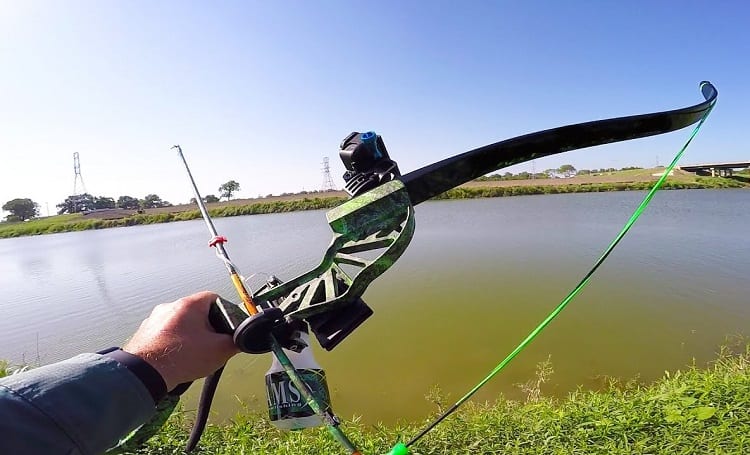
Bowfishing is generally acceptable in most rivers, streams, and lakes.
The best bowfishing is in shallower waters like at the edge of lakes and rivers or in shallow streams and creeks.
There are exceptions to this rule, however, and so we emphasize that it is important that you understand the local laws and regulations that pertain to bowfishing.
Most states will allow you to bowfish in most public bodies of water.
This can include lakes, rivers, and streams.
In coastal areas, this may also include bowfishing in the ocean.
Some states do have limitations to where you can bowfish, so it is important that you do your research before you pick a fishing spot.
Make sure that state laws allow bowfishing in the place that you’ve selected, and also make sure that there are no local laws that may prohibit bowfishing.
If you’ve done your research and you know where you are allowed to bowfish, by law, but you are still not sure of the best bowfishing locations, you may want to enlist the assistance of an expert.
Your local hunting store may be able to give you suggestions on good places to fish, or they may recommend a guide that can show you the best spots.
The benefit of going with a guide the first few times you bow-fish is that they can help you learn the in’s and out’s of bowfishing, and help you navigate the challenges that come with fishing with a bow, and how to properly aim your bow to hit your target.
If you can’t find a good bowfishing guide in your area, you can always try the internet, and look for local bowfishing groups on forums like Facebook.
These groups will often share good fishing spots or places to avoid, based on their own experience.
Do I need a special license to bowfish?
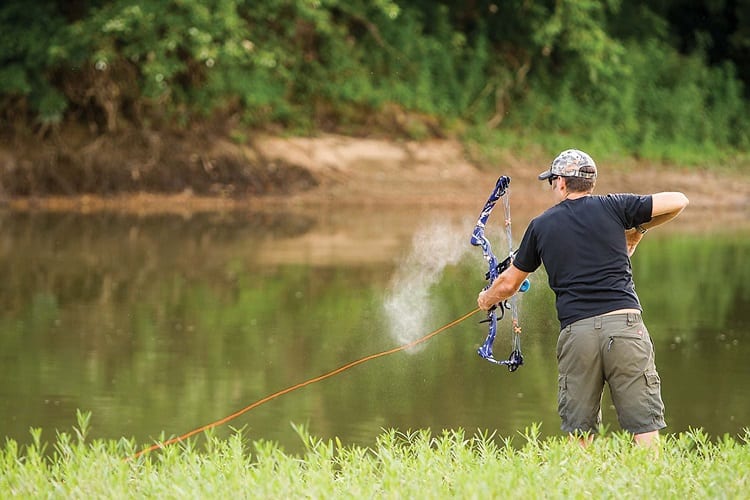
This really depends on where you are going to be fishing, or what state you live in.
Just like with hunting regulations, bowfishing regulations vary from state to state and everyone will tell a different story.
And some local municipalities or counties may also have limitations or special requirements for bowfishing.
Some of the rules that apply to licenses that we’ve seen or heard about are as follows:
- Some states view bowfishing the same as regular fishing. In these states, you will only be required to carry a normal fishing license and follow the same rules as individuals that are fishing with a traditional rod and reel.
- Some states only allow bowfishing for particular species. If you are bowfishing, you will be given a license that only allows you to collect particular types of fish. These licenses may also limit where you can fish, or the times of the year when you can fish for particular species.
- Some states will give you the option of having either a fishing license or a small game hunting license. In these cases, you may have more flexibility with a fishing license, in regards to the time of year that you can bowfish. However, some states don’t have season limitations on small game hunting so this may not be an issue where you might be hunting.
Just remember, before you go fishing, whether it’s with your bow or a traditional rod and reel, that you follow all local and state laws, and if you are fishing on private property, make sure you have landowner permission.
Last Thing…What fish can you bowfish?
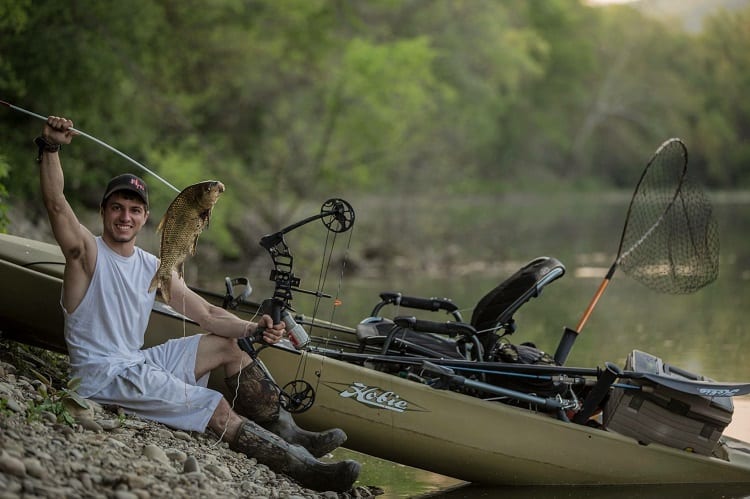
Because bowfishing often comes with limitations to species or season, you will find that you may be fishing for a fairly narrow group of fish.
In most states, bowfishing is allowed for invasive species only or for species that are considered “junk” fish.
Most states will not allow you bowfish for the typical sport fishing species.
Some of the most common types of fish that you can legally bowfish in most states include carp, gar (including alligator gar), suckers, paddlefish, catfish, some types of shad, and tilapia.
There may be alterations to this list, depending on your location but in general, you will find that when it comes to freshwater bowfishing, the fish you can collect is limited.
If you are fishing in coastal areas or in saltwater, there are also some species that you can safely bowfish in most states.
This includes flounder, shark, sheepshead, and rays.
There are some species that you can legally hunt in a few states, but they are protected in others.
Just like with freshwater fishing, make sure you know what is legal to harvest with a bow before you hit the water.
Does bowfishing kill the fish?
Just like with bow hunting, your goal with bowfishing is to get a clean kill-shot and do the right thing.
When you are bowfishing it is important that you aim for the front of the fish.
Like with other animals, the vital organs and brain are located at the front of the animal.
A solid hit in the front of the fish should kill the fish, with a single arrow.
However, some larger game, like alligator gar may require more than one arrow to make a kill.
Bowfishing is always lethal for the target animal, so there is not a catch and release with bowfishing.
Bowfishing is a fun alternative to regular rod and reel fishing.
It is also a great way to add some additional bow hunting skills to your repertoire.
The great thing about bowfishing is that your need for extra gear is limited, and it gives you the opportunity to continue using your bow, even during the spring and summer months.
So, bottom line, next summer, when you’ve tired of the normal fishing routine, break out your bow, and give bowfishing a shot.

